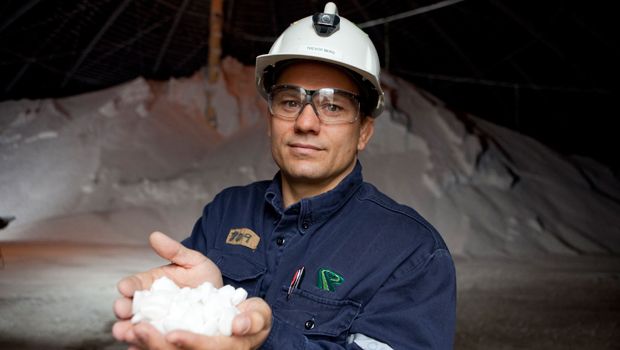
Unlike lithium, potash is not scarce. The resource, however, is concentrated in a few privileged places on the globe, such as Canada, Russia and Belarus.
This fact, in effect, turns the idea of abundance on its ear. Potash is extremely rare if you live in a “have not” country. The concentration of supply, combined with the prohibitive costs associated with establishing a producing mine, means there are a limited number potash suppliers. In fact, just a handful of producers account for 75% of potash production in the world. The two largest potash producers in North America are Potash Corporation of Saskatchewan (TSX:POT) and The Mosaic Company (NYSE: MOS); a Fortune 500 Company based in Minnesota. Silvinit, which is currently in merger talks with Russian counterpart Uralkali, and Belarusian government owned Belaruskali are the dominant players in Asia. Norway’s Yara and Germany’s K + S Kassell are the major producers out of Europe.
Much like lithium, the price of potash is established by direct negotiation between suppliers and buyers. When potash’s price per tonne reached nearly $1,000 in 2008, the inelasticity of supply became very apparent. This gave rise to the “potash bubble” and there was a temporary standoff between buyers and sellers – not many new supply agreements were announced from 2009 to 2010. Without the soil enrichment that potash provides, however, many crop producers run the risk of losing yield. Clearly, this standoff had a built in timer.
The entrance fee to join the exclusive club of potash producers is typically in the billions of dollars. In 2007, one of India’s largest mining companies Sainik Coal Mining was awarded a mining license to begin potash extraction in the Danakil Depression of Ethiopia. Sainik is planning to invest $1.1 billion in the project.
In the developed world that cost is even greater. Russell Carter, managing editor of World of Mining Professionals, recently reported, that “…a new Saskatchewan conventional mine would require an estimated upfront capital investment of C$2.8 billion, excluding roads, rail lines, utilities, port facilities and other infrastructure costs outside the plant gate. It would take a minimum seven years to generate positive cash flow from a newly built conventional mine”.
In April 2008, Mosaic announced that it would expand its three potash operations in Saskatchewan by five million tonnes over the next 12 years at a cost of US$3.15 billion but less than a year later was forced to lay-off 1,000 workers and reign in production as a result of the economic crisis.
Today, Aussie resource giant BHP Biliton, not one to be discouraged by the minor setback of a takeover gone awry has plans for a new potash mine. The Jansen Project is located 140 km east of Saskatoon, Saskatchewan. The mine is expected to be completed by 2015 and has been engineered to produce eight million tonnes of potash each year, or 12 % of the world’s current demand. This mega project is expected to cost $10 billion. With an estimated potash resource of 840 million tonnes and a mine life of perhaps a hundred years, the project provides BHP with a significant entry into the potash market.
Many believe that the rise of potash is not a bubble, but a genuine realignment of the supply demand equation. In their own second quarter analysis Potash Corporation said their research suggests that “…Chinese potash consumption could rise from less than 10m tonnes a year today to 30m by 2020. Indian consumption could jump from less than 6m tonnes to 15m in the same period.” Other proponents suggest that the BHP bid for Potash was not the frothy sign of a bubble at all, but rather, a sign of the bottom. Most reports suggest global demand will continue to rise by approximately 3% per year.
So with supply tightly concentrated in a few hands and demand steady, it appears potash will be news for some time to come. But where should investors in the sector be turning their attention to today? MiningFeeds.com breaks down five interesting candidates.
1. Potash Corporation of Saskatchewan (TSX:POT)
Location, location, location. Saskatchewan, the once sleepy little prairie province that is home to just over a million people, is home to half the world’s total supply of potash.
Half a decade ago, that fact was a footnote. Today, with the price of potash having risen from $190 to over $500 a metric tonne, it’s headline news. Potash Corp has done very well. Well enough, in fact, that the world came calling in the form of a hostile takeover attempt from BHP Bilington.
In mid-November 2010, after the Canadian government stone-walled the potential deal, BHP announced it had withdrawn its $38.6 billion unsolicited takeover offer for the Potash Corporation of Saskatchewan. Both Potash and the Saskatchewan government fiercely lobbied Canada’s Conservative government to block the deal, citing what amounted to national security concerns. Potash produces about 23% of the world’s supply of the newly important material and generates significant revenue for the Saskatchewan government.

The Canadian federal government, led by Industry Minister Tony Clement formally scuttled the Potash deal because it didn’t represent a “net benefit” to Canadians. The decision, which was made under the Investment Canada Act, was an assessment some felt was too subjective. Clement, obviously feeling the precarious nature of his position, gave the Australian mining giant a thirty day window to restate its case and make any additional representations to Ottawa. But BHP Biliton elected to terminate the offer and forgo the red tape.
Potash’s fiscal 2010 results, released on February 20th, punctuated the reasons BHP Biliton was so keenly interested in Saskatchewan’s largest company. Top line sales were a whopping $6.54 billion and the company was extremely profitable, reporting net income of $1.81 billion, or $1.98 per share.
With one thwarted hostile takeover under its belt, it is clear Potash Corporation of Saskatchewan now plays on an international stage. The company, to its credit, isn’t showing any signs of stage fright. By 2015, Potash expects its annual potash operational capability to reach 17.1 million tonnes, almost twice what it was in 2005 when construction was completed on its first expansion project. Management now says it expects to increase production by almost 70% over the next five years.
2. Allana Potash (TSXV: AAA)
Potash is hot. Allana’s potash might be just a little hotter.
That’s because Toronto based Allana Potash’s property is located in the Danakil Depression of Ethiopia one of the lowest places on earth not covered by water, and, with temperatures routinely soaring to over 60 Celcius, the hottest. When Potash was discovered in this basin near the Red Sea in 1918, most wouldn’t blame anyone for simply turning their back on it. But the quality and amount of potash available here, as Allana’s short experience is already proving, means the appeal is simply too lucrative, even in the excruciating heat of the Danakil Desert.
Potash production began in the Danakil in 1918 after a railway was completed from the port of Mersa Fatma in Eritrea to an area 28 km outside of Dallol. But when large-scale supplies from Germany, USA, and USSR came to market after the Second World War the region sat dormant for decades.
But just a few years ago, with Potash high in demand again, Etiopia and Eritrea governments granted a number of licenses. Allana’s property surrounds Sainik’s Crescent Potash Project and is adjacent to BHP Billiton’s holdings in the Depression. When Allana acquired its Ethiopian potash concessions in September, 2008 the transaction was supported by a NI-43-101 compliant technical report from ERCOSPLAN Ingenieurgesellschaft and North Rim Exploration. That report showed an inferred mineral resource of 105,200,000 tonnes of potash mineralization (Sylvite and Kainite) with a composite grade of 20.8% KCl and near surface mineralization was present.
Since acquiring the concessions Allana has been busy developing the project, attracting a $12.3 million strategic investment from Liberty Metal and Mining; 17% ownership stake, and a two million dollar investment from China Mineral United Management. Then, On March 1st, Allana completed a $38 million financing from a syndicate of brokers and an over-allotment option from Liberty Metals.
Recently The MiningFeeds.com talked to Farhad Abasov, President and CEO of Allana Potash about their experience in the Danakil and the 154,000 hectares land position the company holds in the Nequen province of Argentina. For the exclusive interview CLICK HERE.
For 5 Potash Stocks to Watch in 2011 – Part 2 – CLICK HERE.



 Follow us on Twitter
Follow us on Twitter Become our facebook fan
Become our facebook fan










Comments are closed.